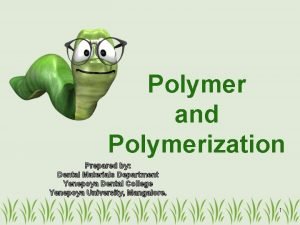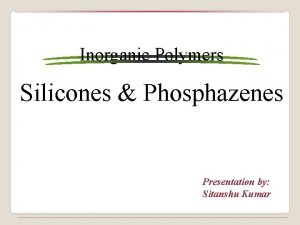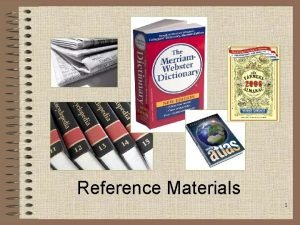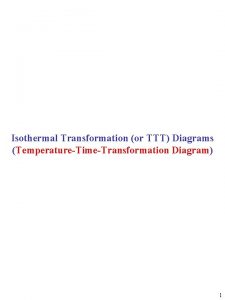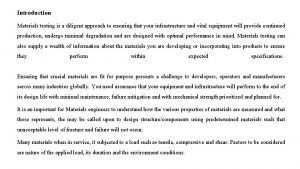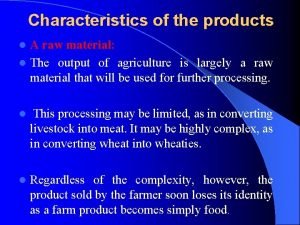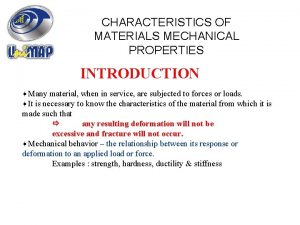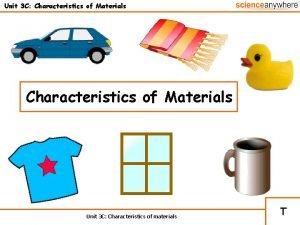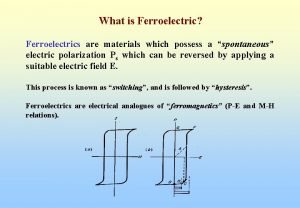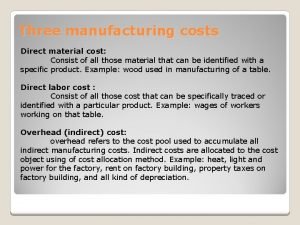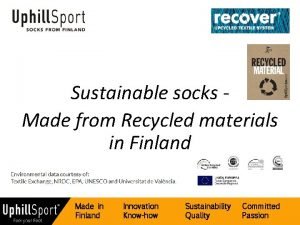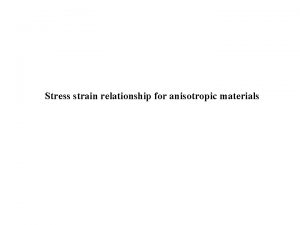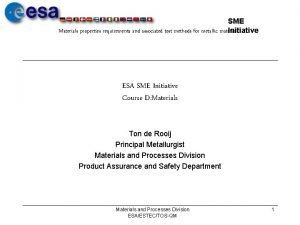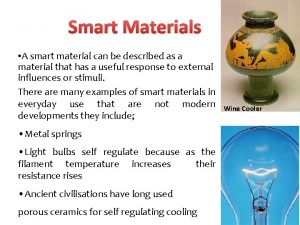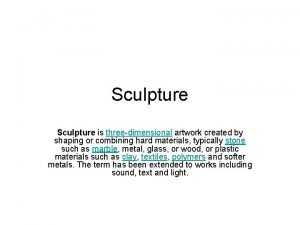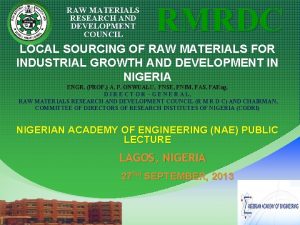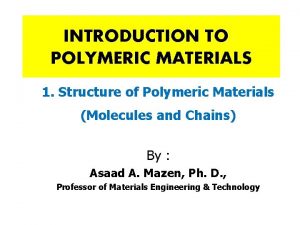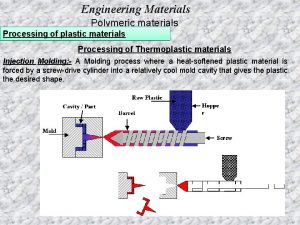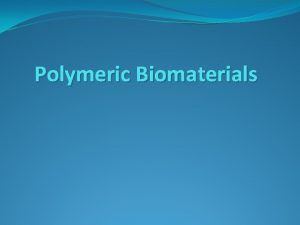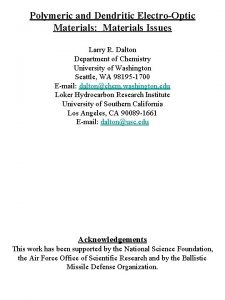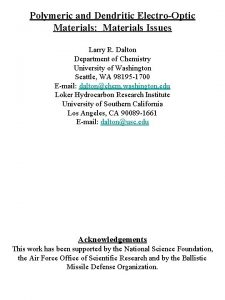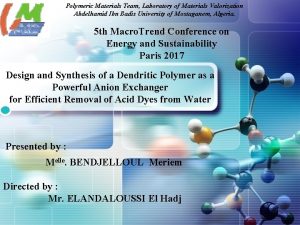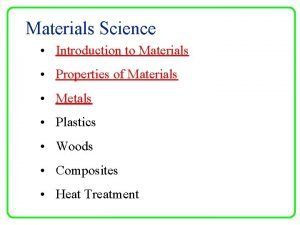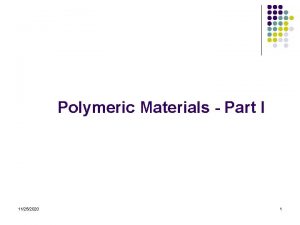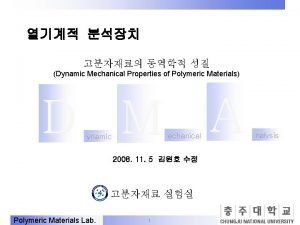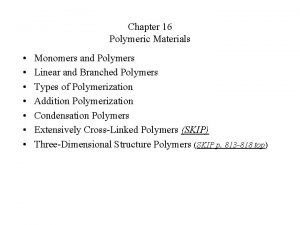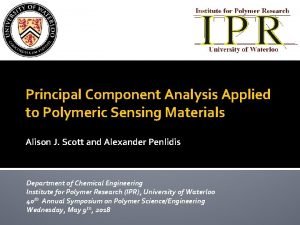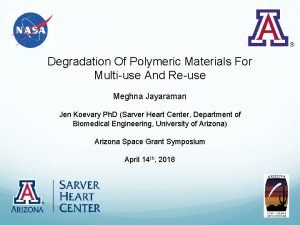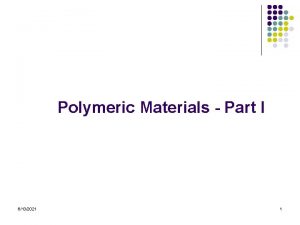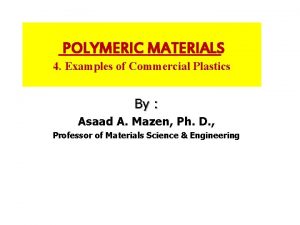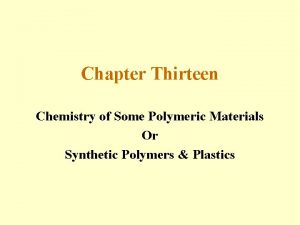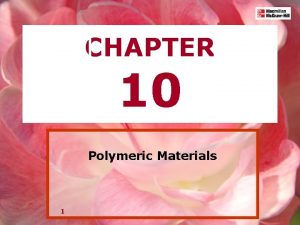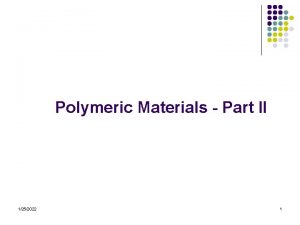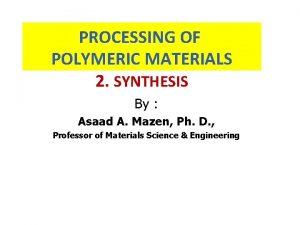INTRODUCTION TO POLYMERIC MATERIALS 2 Characteristics of Polymeric


























































- Slides: 58

INTRODUCTION TO POLYMERIC MATERIALS 2. Characteristics of Polymeric Materials By : Asaad A. Mazen, Ph. D. , Professor of Materials Science & Engineering

2. Characteristics of Polymeric Materials 2. 1 Molecular Mass of a Mer : mw Is the sum of atomic masses of the atoms making the mer. Example: Consider Polyethylene (PE) C 2 H 4 The molecular weight of a polyethylene mer is : mw = 2 (12) + 4 (1) = 28 amu (or gm/mol)

2. 2 average molecular weight of a polymer During the polymerization process not all polymer chains will grow to the same length; this results in a distribution of chain lengths or molecular weights. Ordinarily, an average molecular weight is specified, which may be determined by the measurement of various physical properties such as viscosity and osmotic pressure. There are several ways of defining average molecular weight of a polymer :

2. 2. average molecular weight of a polymer a. The number average molecular weight Mn: is obtained by dividing the chains into a series of size ranges and then determining the number fraction of chains within each size range(Figure 14. 3 a). The number-average molecular weight is expressed as where Mi represents the mean (middle) molecular weight of size range i, and xi is the fraction of the total number of chains within the corresponding size range.

2. 2 average molecular weight of a polymer

2. 2 average molecular weight of a polymer b. The weight average molecular weight Mw: is obtained by dividing the chains into a series of weight ranges and then determining the number fraction of chains within each weight range(Figure 14. 3 a). The weight-average molecular weight is expressed as: Where Mi is the mean molecular weight within a size range, whereas wi denotes the weight fraction of molecules within the same size interval

2. 2. average molecular weight of a polymer A typical molecular weight distribution along with these molecular weight averages is shown in Figure 14. 4.

2. 3. Degree of Polymerization : DP It represents the average number of repeat units in a chain. DP is related to the numberaverage molecular weight by the equation DP = Mn / mw Mn is the number average molecular weight , mw is the molecular weight of the mer

Calculations of Molecular Weight and Degree of Polymerization

Calculation of Number-Average Molecular Weight

Calculation of Weight-Average Molecular Weight

2. 4. Polymer Crystallinity Amorphous State vs. Crystalline State :

2. 4. 1 Types of Material Structures a) Amorphous Materials Amorphous (or noncrystalline solids) : Are materials whose microstructures lack a systematic and regular arrangement of atoms over large (3 -D) atomic distances. Amorphous (meaning literally without form) materials are sometimes called supercooled liquids, in asmuch as their atomic structure resembles that of a liquid.

2. 4. 1 Types of Material Structures

2. 4. 1 Types of Material Structures Microstructure Source : J. Adv. Mat & Processes, Vol. 163, No. 2, Feb. 2005.

2. 4. 1 Types of Material Structures a) Amorphous Materials Whether a crystalline or amorphous solid forms depends on : ease with which a random atomic structure in the liquid can transform to an ordered state during solidification. f( latent heat of solidification, bond energy, Amorphous materials, therefore, are characterized by atomic or molecular structures that are relatively complex and become ordered only with some difficulty.

2. 4. 1 Types of Material Structures a) Amorphous Materials b) Cooling Rate During Solidification Rapid cooling through the freezing avors the formation of a noncrystalline solid, since little time is allowed the ordering. plexity of atomic or molecular structure ome materials favors formation of amorphous than crystalline ones due to the omplexity of their microstructue, e. g. glasses, many polymeric materials, some ceramics. for

2. 4. 2 Polymer Crystallinity Polymer crystallinity is the packing of molecular chains to produce an ordered atomic array. The crystalline state may exist in polymeric materials. However, because it involves molecules instead of just atoms or ions, as with metals and ceramics, the atomic arrangements will be more complex for polymers.

2. 4. 2 Polymer Crystallinity Crystal structures of Crystalline Polymers Crystal structures of crystalline polymers may be specified in terms of unit cells. Unit cells are often quite complex. For example, Figure 14. 10 shows the unit cell for polyethylene C 2 H 4 and its relationship to the molecular chain structure. Of course, the chain molecules also extend beyond the unit cell shown in the figure.

2. 4. 3 Polymer Unit Cells Arrangement of molecular chains in a unit cell for polyethylene.

2. 4. 3 Crystallinity in Polymers Molecular substances having small molecules (e. g. , water and methane) are normally either totally crystalline (as solids) or totally amorphous (as liquids). As a consequence of their size and often complexity, polymer molecules are often only partially crystalline (or semicrystalline), having crystalline regions dispersed within the remaining amorphous material.

2. 4. 4 Degree of Crystallinity The degree of crystallinity may range from completely amorphous to almost entirely (up to about 95%) crystalline; in contrast, metal specimens are almost always 100% crystalline, whereas many ceramics are either totally crystalline or totally noncrystalline.

2. 4. 4 Degree of Crystallinity The density of a crystalline polymer will always be greater than an amorphous one of the same material and molecular weight, because the chains are more closely packed together for the crystalline structure. Crystalline polymers are usually stonger and more resistant to dissolution and softening by heat.

2. 4. 4 Degree of Crystallinity The degree of crystallinity by weight may be determined from accurate density measurements, according to:

2. 4. 4 Degree of Crystallinity Where e density of a specimen for which the percent crystallinity is to be determined, ensity of the totally amorphous polymer, and, density of the perfectly crystalline polymer. The values of a and c must be measured by other experimental means.

2. 4. 5 Factors Affecting Degree of Crystallinity 1. The rate of cooling during solidification, 2. The chain configuration. During crystallization upon cooling through the melting temperature, the chains, which are highly random and entangled in the viscous liquid, must assume an ordered configuration. For this to occur, sufficient time must be allowed for the chains to move and align themselves.

2. 4. 5 Factors Affecting Polymeric Crystallinity chain disorder or misalignment : will result in an amorphous region, i. e. twisting, kinking, coiling, branching, cross-linking, and networking of the chains prevent the strict ordering of every segment of every chain. Other structural effects are also influential in determining the extent of crystallinity.

2. 4. 5 Factors Affecting Degree of Crystallinity Crystallization is not favored in polymers that are composed of chemically complex repeat units (e. g. , polyisoprene). On the other hand, crystallization is not easily prevented in chemically simple polymers such as polyethylene and polytetrafluoroethylene, even for very rapid cooling rates.

2. 4. 5 Factors Affecting Degree of Crystallinity Linear polymers : crystallization is easily accomplished because there are few restrictions to prevent chain alignment. Branched polymers : Any side branches interfere with crystallization, thus, branched polymers are never highly crystalline; in fact, excessive branching may prevent any crystallization whatsoever.

2. 4. 5 Factors Affecting Degree of Crystallinity Networked and crosslinked polymers: are almost totally amorphous because the crosslinks prevent the polymer chains from rearranging and aligning into a crystalline structure. A few crosslinked polymers are partially crystalline. Also, the bulkier or larger the side-bonded groups of atoms, the less the tendency for crystallization.




2. 4. 6 POLYMER CRYSTALS A semicrystalline polymer consists of small crystalline regions (crystallites), each having a precise alignment, which are interspersed with amorphous regions composed of randomly oriented molecules.

2. 4. 6 Polymer Crystals 2. 4. 6. 1 Crystallites polymer single crystals may be grown from dilute solutions. These crystals are regularly shaped, thin platelets (or lamellae), approximately 10 to 20 nm thick, and on the order of 10 µm long. Frequently, these platelets will form a multilayered structure, like that shown in the electron micrograph of a single crystal of polyethylene, Figure 14. 11

2. 4. 7 Examples: Polyethylene Single Crystals (Crystallites) Electron micrograph of a polyethylene single crystal. 20, 000 X

2. 4. 7. 2 Chain Folded Crystals The molecular chains within each platelet fold back and forth on themselves, with folds occurring at the faces; this structure, termed the chain-folded model, is illustrated schematically in Figure 14. 12. Each platelet will consist of a number of molecules; however, the average chain length will be much greater than the thickness of the platelet.

The Chain Folded Model

The Chain Folded Model In this electron micrograph, these lamellae appear as thin white lines. The detailed structure of a spherulite is illustrated schematically in Figure 14. 13. Shown here are the individual chain-folded lamellar crystals that are separated by amorphous material. Tie-chain molecules that act as connecting links between adjacent lamellae pass through these amorphous regions.

The Spherulite Model Many bulk polymers that are crystallized from a melt are semicrystalline and form a spherulite structure. As implied by the name, each spherulite may grow to be roughly spherical in shape. The spherulite consists of an aggregate of ribbon-like chain-folded crystallites (lamellae) approximately 10 nm thick that radiate outward from a single nucleation site in the center.

The Spherulite Model

The Spherulite Model In this electron micrograph, these lamellae appear as thin white lines. The detailed structure of a spherulite : In Figure 14. 13, the individual chain-folded lamellar crystals separated by amorphous material are shown. Tie-chain molecules that act as connecting links between adjacent lamellae pass through these amorphous regions.

The Spherulite Model As the crystallization of a spherulitic structure nears completion, the extremities of adjacent spherulites begin to impinge on one another, forming more or less planar boundaries; prior to this time, they maintain their spherical shape. These boundaries are evident in Figure 14. 14, which is a photomicrograph of polyethylene using crosspolarized light. A characteristic Maltese cross pattern appears within each spherulite.

The Spherulite Model The bands or rings in the spherulite image result from twisting of the lamellar crystals as they extend like ribbons from the center. Spherulites are considered to be the polymer analogue of grains in polycrystalline metals and ceramics. However, as discussed above, each spherulite is really composed of many different lamellar crystals and, in addition, some amorphous material. Polyethylene, polypropylene, polytetrafluoroethylene, poly(vinyl chloride), and nylon form a spherulitic structure when they crystallize from a melt.

2. 8. DEFECTS IN POLYMERS Point defects These include vacancies and interstitial atoms and ions. Chain ends are considered to be defects because they are chemically dissimilar to normal chain units. Vacancies are also associated with the chain ends (Figure 14. 15). Additional defects can result from branches in the olymer chain or chain segments that emerge from the crystal.

• Schematic representation of defects in polymer crystallites.

2. 8. DEFECTS IN POLYMERS Impurity atoms/ions or groups of atoms/ions may be incorporated in the molecular structure as interstitials; they may also be associated with main chains or as short side Line Defects : A chain section can leave a polymer crystal and reenter it at another point creating a loop, or can enter a second crystal to act as a tie molecule.

Planar (area or interfacial ) The surfaces of chain-folded layers (Figure 14. 13) are considered to be interfacial defects, as are also boundaries between two adjacent crystalline regions.

2. 9 DIFFUSION IN POLYMERIC MATERIALS. For polymeric materials, our interest is often in the diffusive motion of small foreign molecules (e. g. , O 2, H 2 O, CO 2, CH 4) between the molecular chains, rather than in the diffusive motion of chain atoms within the polymer structure. A polymer’s permeability and absorption characteristics relate to the degree to which foreign substances diffuse into the material.

2. 9. DIFFUSION IN POLYMERIC MATERIALS Penetration of these foreign substances can lead to swelling and/or chemical reactions with the polymer molecules, and often a degradation of the material’s mechanical and physical properties. Characterization of diffusion properties: Characterization of diffusion properties of polymers are often expressed in terms of a permeability coefficient.

2. 9. DIFFUSION IN POLYMERIC MATERIALS Permeability coefficient: ( for the case of steady-state diffusion through a polymer membrane), Fick’s first law (Equation 5. 3), is modified as J = Pm d. P / dx J is the diffusion flux of gas through the membrane [(cm 3 STP)/(cm 2 -s)], Pm is the permeability coefficient, Δx is the membrane thickness, and, e difference in pressure of the gas across the membrane.

2. 9. DIFFUSION IN POLYMERIC MATERIALS For small molecules in nonglassy polymers the permeability coefficient can be approximated as: the product of the diffusion coefficient (D) and solubility (S), of the diffusing species in the polymer : Pm = D S

2. 10. Factors Affecting Diffusion in Polymeric Materials 1. Effect of Material State : Rates of diffusion are greater through amorphous regions than through crystalline regions; the structure of amorphous material is more “open. ” 2. Effect of Foreign molecule size Size also affects the diffusion rate: smaller molecules diffuse faster than larger ones. 3. Effect of Reactivity of Molecules : Diffusion is more rapid foreign molecules that are chemically inert than for those that react with the polymer

2. 10. Applications of Permeability of Polymers For some applications, low permeability rates through polymeric materials are desirable, as with food and beverage packaging and automobile tires and inner tubes. Polymer membranes are often used as filters, to selectively separate one chemical species from another (or others) (i. e. , the desalinization of water). In such instances it is normally the case that the permeation rate of the substance to be filtered is significantly greater than for the other substance(s).


2. 10. 1 Example : The Plastic Beverage Container


THE END
 Dental monomer and polymer
Dental monomer and polymer Silicones and phosphazenes
Silicones and phosphazenes Transversion
Transversion Go noodle cant stop the feeling
Go noodle cant stop the feeling How would you differentiate useful from harmful materials
How would you differentiate useful from harmful materials Natural man made
Natural man made Adopting materials
Adopting materials Direct materials budget with multiple materials
Direct materials budget with multiple materials What are reference materials
What are reference materials Crown lengthening procedure steps ppt
Crown lengthening procedure steps ppt Introduction to materials science for engineers chapter 10
Introduction to materials science for engineers chapter 10 Define material handling
Define material handling Introduction to dental materials
Introduction to dental materials Introduction to materials science for engineers chapter 10
Introduction to materials science for engineers chapter 10 Introduction to materials testing
Introduction to materials testing Introduction of material handling
Introduction of material handling Characteristic of raw materials
Characteristic of raw materials Characteristics of materials
Characteristics of materials Unit 3 c
Unit 3 c Body paragraph structure
Body paragraph structure Chapter 24 section 1 animal characteristics
Chapter 24 section 1 animal characteristics What type of reading materials do you prefer?
What type of reading materials do you prefer? Material technology positive and negative impacts
Material technology positive and negative impacts Light is a form of *
Light is a form of * What is ferroelectricity
What is ferroelectricity Alan nye rit
Alan nye rit History of smart materials
History of smart materials Materials transformats
Materials transformats Categorizing materials
Categorizing materials Opaque translucent
Opaque translucent What are the materials needed in making
What are the materials needed in making Time management training materials
Time management training materials Product costs consist of
Product costs consist of Taino diet
Taino diet Prepare the following materials
Prepare the following materials Positive impacts of materials technology
Positive impacts of materials technology Tea science reference materials
Tea science reference materials Centura 5200 ultima
Centura 5200 ultima Finland socks
Finland socks Sustainable materials
Sustainable materials Anisotropic material examples
Anisotropic material examples Strawberry dna extraction materials
Strawberry dna extraction materials Sme materials
Sme materials Smart materials examples
Smart materials examples Effects of light on smart and modern materials
Effects of light on smart and modern materials Polymorph smart material
Polymorph smart material Difference between smart and modern materials
Difference between smart and modern materials A 3-d work of art created by shaping or combining materials
A 3-d work of art created by shaping or combining materials Direct material sourcing ariba
Direct material sourcing ariba Concrete parapet wall
Concrete parapet wall Rmrdc salary for corpers
Rmrdc salary for corpers Construction materials names and pictures
Construction materials names and pictures Pneumatic structures materials
Pneumatic structures materials Remedial teaching materials for slow learners
Remedial teaching materials for slow learners Reggio emilia and open-ended materials
Reggio emilia and open-ended materials Control of raw materials
Control of raw materials Presenting room service account script
Presenting room service account script Preventive materials in dentistry
Preventive materials in dentistry Piezoelectric applications ppt
Piezoelectric applications ppt
